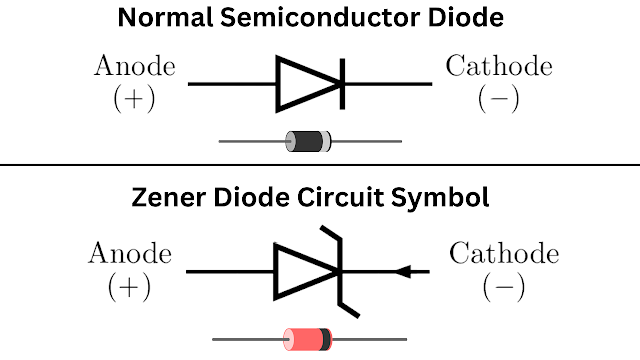What is Zener Diode?
A Zener diode is a special type of semiconductor diode that is designed to work in the reverse-biased mode. It is not like regular diodes, which allow current to flow in one direction only. Zener diodes are engineered to conduct in the reverse direction when a specific voltage, known as the Zener voltage, is applied.
Once the voltage across the Zener diode reaches or exceeds its Zener voltage, it starts to conduct and allow current to flow in the reverse direction without getting damaged.
Zener diodes are primarily used for voltage regulation and voltage reference purposes in electronic circuits. They maintain a constant voltage across their terminals. This characteristic makes them useful in applications where a stable voltage supply is necessary, such as power supplies, voltage regulators, and voltage reference circuits.
Zener diodes are named after physicist Clarence Zener. He first discovered the Zener effect, which is the phenomenon that allows these diodes to operate as voltage regulators.
Actually when a typical semiconductor diode is reverse-biased, a very small amount of saturated reverse current flows through it due to the flow of minority carriers, i.e. thermal electrons and holes. This current is not at all dependent on the applied reverse bias voltage.
However, when this reverse bias voltage exceeds a certain value, the reverse current suddenly increases very rapidly. This phenomenon is called semiconductor diode breakdown. This results in a rapid increase in the diode's power dissipation, i.e. the rate of heat generation, potentially damaging the diode.
The tolerance of some specially prepared semiconductor diodes is increased so that high reverse current in reverse bias does not damage the diode i.e. it does not burn out.
What is Zener Effect?
When the reverse bias voltage of a diode becomes high enough, electrons and holes are accelerated as minority carriers. Because of this high speed, they can break the bonds between semiconductor cells, resulting in the formation of new electron-hole pairs.
They are also faster, so they can form more electron-hole pairs. Thus the number of charge carriers increases exponentially and the reverse diode current reaches very high values. This phenomenon is called avalanche breakdown and the diode is called an avalanche diode.
If both parts of a semiconductor diode i.e. p-n junction are heavily doped, the thickness of the depletion region is greatly reduced. A very small reverse bias is then applied, but a very high electric field is generated between the two ends of the depletion region.
This electric field directly breaks the bonds in the semiconductor cell and frees a large number of charge carriers within the cell. This results in diode distortion due to relatively low reverse bias voltage. That is, the diode reaches a reverse current multiplier state at a low constant breakdown voltage. This condition is called Zener breakdown or Zener effect. Such diodes are known as Zener diodes.
Characteristic Curve of Zener diode
The ampere-volt characteristic curve of the Zener diode in forward bias is similar to the characteristic curve of a typical semiconductor diode. But when the reverse bias voltage reaches a certain value (at Vz), the reverse current increases rapidly. There is no significant change in voltage.
This part of the characteristic is roughly indicated by a vertical line. In an ideal Zener diode, the increase in voltage is zero as the current increases. In real cases, this increase is between 1% and 5%.
Circuit Symbol of Zener Diode
A Zener diode is represented by a regular diode symbol with two additional lines at its ends, forming a kind of "z" shape. These lines indicate that the diode can conduct in both the forward and reverse directions when the voltage across it reaches the Zener voltage.
In this symbol, the arrow represents the direction of conventional current flow, just like in a regular diode. The "z" shape lines indicate that the diode can conduct in both directions when the voltage reaches or exceeds the Zener voltage.
Remember, the Zener diode symbol looks like a regular diode but with those extra lines, showing its special ability to regulate voltage in electronic circuits.
Applications of Zener diode
Here are some common applications of Zener diodes:
1. Voltage Regulation: Zener diodes are widely used for voltage regulation in electronic circuits. They maintain a stable output voltage despite fluctuations in input voltage and ensure the connected components receive a consistent power supply.
2. Voltage Shifting: Zener diodes are employed in voltage-shifting circuits. By combining them with other components, Zener diodes can shift the voltage levels of signals and make them compatible with different parts of a circuit.
3. Overvoltage Protection: Zener diodes act as protectors in electronic circuits. When the voltage across them exceeds a certain threshold, they conduct heavily, diverting excess current and preventing damage to sensitive components by limiting the voltage levels.
4. Waveform Clipping: Zener diodes are used to clip or limit the amplitude of alternating current (AC) waveforms. By allowing only voltages above or below a certain level to pass through, Zener diodes shape the waveform according to the desired specifications.
5. Temperature Sensing: Zener diodes exhibit a stable voltage drop with temperature variations. This property is utilized in temperature-sensitive applications. By measuring the voltage across a Zener diode, changes in temperature can be accurately monitored This enables them to create temperature-sensitive control systems.




Post a Comment (0)